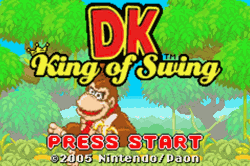 Let’s hear it for Donkey Kong, the incredible ape that only has a few actions, but can do ‘em a million different ways.
Let’s hear it for Donkey Kong, the incredible ape that only has a few actions, but can do ‘em a million different ways.
… Or at least three.
To start, we have to address DK’s most hated rival: Mario. Or… well… they seem to be getting along pretty well at this moment, but they do have the occasional issue over copyright disputes. Regardless, as you may be aware, Mario has starred in a number of games. And it’s not just his popular adventures jumping across the Mushroom Kingdom, Mario has been everything from a tennis ace to a kart racer to a medical doctor. Mario had more spin-off titles before the end of the NES than many gaming heroes had individual “main franchise” games. Mario, designed to be like Mickey Mouse, Bugs Bunny, or Tom Hanks, could fill many roles and serve many masters. Mario has to headline a golf game now? Sure! Princess Peach can be caddy for some reason.
But there’s a problem with Mario appearing in so many roles: he has lost sight of his original moveset. Mario runs and jumps. It has been there from the beginning, and his greatest hits have ultimately boiled down to those simple motions. Mario jumps. It’s his thing. And even when Mario leaps from system to system, you have a basic idea of how his physics are going to fare in the new dimensions. … Except, when, ya know, there is no jumping. There is, at best, a tiny hop in Mario Kart. Mario nary jumps an inch in Dr. Mario. Picross is right out. And even titles that are not action games, but do pay homage to Mario’s ups, feature a Mario that is, at best, hobbled. Mario & Luigi or Super Mario RPG literally talk about the great jumping Mario, but it’s still not the primary way Mario interacts with his world. It’s telling how quickly Mario discovers a fire flower or hammer (or both!) in those titles…
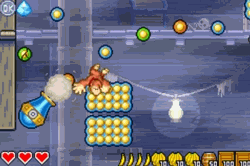 And, in a way, that’s absolutely fine! You don’t need running and jumping to toss pills of dubious scientific origins at viruses, and RPGs shouldn’t have puzzles where the solution is “run better”. Mario has existed across genres and playstyles, and the fact that he adapts to each new challenge like he always belonged there is a feature, not a bug. Mario can compete in the Olympics, and his caretakers don’t have to find a way to squeeze a mystical mushroom into the already complex, shot put-based gameplay.
And, in a way, that’s absolutely fine! You don’t need running and jumping to toss pills of dubious scientific origins at viruses, and RPGs shouldn’t have puzzles where the solution is “run better”. Mario has existed across genres and playstyles, and the fact that he adapts to each new challenge like he always belonged there is a feature, not a bug. Mario can compete in the Olympics, and his caretakers don’t have to find a way to squeeze a mystical mushroom into the already complex, shot put-based gameplay.
But that does mean Mario loses something along the way. If you pick up Mario Kart expecting typical Mario gameplay, you’re going to have a bad time. If you only want a traditional Mario game, but with a whole lot more dialogue, then the latest Mario RPG is going to leave you wanting. Mario might be right there in the title, and he might be the focus of the core concept, but that’s no guarantee that Mario will be the Mario that you remember. Mario is always going to be Mario, yes, but there’s no promise his latest outing is going to feature a Mario that simply runs, jumps, and occasionally menaces turtles.
Donkey Kong, though, now there’s a reliable ape.
The Donkey Kong official timeline is a little blurry, but the first playable “Donkey Kong” was definitely Donkey Kong Junior. DK Jr. controlled much like Mario, though with the moveset addition of “can climb”. This was required across all levels, and, in some stages, was little more than an evolution of Mario’s ability to “press up”. However, some levels (including the finale!) were almost entirely climbing based, so, while a horizontally traveling DK Jr. was very similar to his father’s captor, an ape on a vine was a different animal from a plumber on a ladder. As such, we learned the one thing that DK has over Mario: he’s an experienced climber. DK Tarzan, Mario plain.
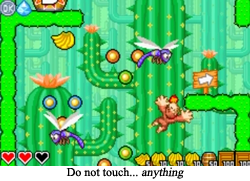 Then Donkey Kong took some time off to discover himself, learn math, figure out how ties work, and eventually returned a decade or so later. The “new” Donkey Kong of Donkey Kong Country was not confined to a scant few stages, but had an entire, enormous island to explore. He had his own reptilian villain, a fresh addiction to yellow fruit, and a little buddy that was so happy, he’s doing cartwheels. But Donkey Kong? Donkey Kong, at his core, was still doing the exact same things. He ran. He jumped. He swung on vines. The only new addition for the player was DK having some offensive options, like tossing barrels, but that was something the big guy did right from his first appearance (even if the player didn’t have any input on when he did it). Donkey Kong felt different from his DK Jr. days, but the same basic moves were all there. To some, this might seem like the old monkey couldn’t learn new tricks, but to others, this was glorious familiarity. And that’s very important when a videogame character resurfaces on an entirely new system with unfamiliar graphics.
Then Donkey Kong took some time off to discover himself, learn math, figure out how ties work, and eventually returned a decade or so later. The “new” Donkey Kong of Donkey Kong Country was not confined to a scant few stages, but had an entire, enormous island to explore. He had his own reptilian villain, a fresh addiction to yellow fruit, and a little buddy that was so happy, he’s doing cartwheels. But Donkey Kong? Donkey Kong, at his core, was still doing the exact same things. He ran. He jumped. He swung on vines. The only new addition for the player was DK having some offensive options, like tossing barrels, but that was something the big guy did right from his first appearance (even if the player didn’t have any input on when he did it). Donkey Kong felt different from his DK Jr. days, but the same basic moves were all there. To some, this might seem like the old monkey couldn’t learn new tricks, but to others, this was glorious familiarity. And that’s very important when a videogame character resurfaces on an entirely new system with unfamiliar graphics.
This iteration of Donkey Kong stuck around for a generation or so, and stayed consistent (give or take a coconut gun that can fire in spurts). And then, once Donkey Kong (and Nintendo) separated from Rare, things got interesting.
Four years after Donkey Kong 64, Donkey got his own official Nintendo Peripheral. The DK Bongos were a pair of bongos (of course!) poorly posing as a controller. They were Nintendo’s answer to the Taiko Drums or Guitar Heroes of other systems, but they were used for more than mere rhythm games. The DK Barrels led to not only the prerequisite Donkey Konga, but also Donkey Kong Jungle Beat. DKJB was controlled entirely via bongos, and felt very different from every action platformer that had ever come before. But you know how DK navigated this brave new world? He ran, jumped, and swung on vines. DK: Jungle Beat felt wholly new and different from literally any game that had come before, but Donkey Kong was still very much Donkey Kong. And that familiarity is a godsend when you’re trying to grapple with a controller that somehow involves clapping.
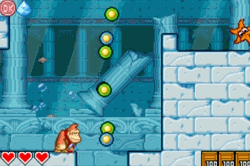 And then DK’s experimental phase continued with DK: King of Swing. In this adventure, our dear Donkey Kong can run and jump, but he isn’t so much into those ground-based activities anymore. Donkey Kong has taken to the skies, and is going down swinging. Or up? He’s still going in whatever direction you want. In fact, he’s going in every direction, as the gameplay of DK: King of Swing is literally going in circles. The primary challenge involved is stopping the big guerilla’s rotation at exactly the right time. In this manner, DK is able to do all his usual moves, as “jumping” or “throwing” are now simply lesser facets of “twirling”. It’s an entirely different way to control Donkey Kong, but his moves are still familiar.
And then DK’s experimental phase continued with DK: King of Swing. In this adventure, our dear Donkey Kong can run and jump, but he isn’t so much into those ground-based activities anymore. Donkey Kong has taken to the skies, and is going down swinging. Or up? He’s still going in whatever direction you want. In fact, he’s going in every direction, as the gameplay of DK: King of Swing is literally going in circles. The primary challenge involved is stopping the big guerilla’s rotation at exactly the right time. In this manner, DK is able to do all his usual moves, as “jumping” or “throwing” are now simply lesser facets of “twirling”. It’s an entirely different way to control Donkey Kong, but his moves are still familiar.
And that’s important when adapting your protagonist to different gameplay. Let’s face it, DK: KoS is the sequel to Nintendo’s long forgotten Clu Clu Land. This is the evolution, the “super” version of a game that was released in 1984. But it is not “a Clu Clu Land” game. This is unmistakably a Donkey Kong game. DK has a certain heft to his movements that is completely absent from other platformers. It’s the same weight that allowed him to roll off a cliff to grab a K emblem in the Donkey Kong Country titles. It’s the same weight that allowed DK to be controlled by frantic bongo drumming. It’s even right there at the beginning when DK Jr. cut across a stage with a well-placed jump on a spring. That same monkey momentum was taken to Clu Clu Land’s basic setup, and allowed for a hero that could propel himself through the air with a spin and a flourish. This is Donkey Kong moving like he has never moved before, but he feels right while performing those familiar physical feats.
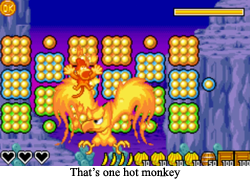 And that’s why Donkey Kong works. That’s why DK: King of Swing, Donkey Kong Jungle Beat, and his later return to Donkey Kong Country all work. Donkey Kong has been consistent in his appearances for decades, and that allows for some superficially inconsistent gameplay. Even though everything seems different, it simmers down to something that is very much the same, and thus immediately understandable. DK: King of Swing is a very different kind of Donkey Kong game, but it works because Donkey Kong continues to be Donkey Kong.
And that’s why Donkey Kong works. That’s why DK: King of Swing, Donkey Kong Jungle Beat, and his later return to Donkey Kong Country all work. Donkey Kong has been consistent in his appearances for decades, and that allows for some superficially inconsistent gameplay. Even though everything seems different, it simmers down to something that is very much the same, and thus immediately understandable. DK: King of Swing is a very different kind of Donkey Kong game, but it works because Donkey Kong continues to be Donkey Kong.
So, congratulations Donkey Kong, you’re more consistent than Mario, and that allows you to feature in more experimental games while still maintaining your identity. You finally beat that plumber at something.
And I bet Pauline isn’t even going to notice…
FGC #498 DK: King of Swing
- System: Gameboy Advance, and then nothing ever again. The game was well-received in its time! I think!
- Number of players: There’s an entire competitive multiplayer mode that is separate from the main, one-player campaign. It’s a four player game as a result, and at least one player can be Wrinkly Kong’s Ghost. It is exactly as macabre as it sounds.
- What about single player? For some reason, only Diddy Kong mode is unlockable as an alternative to Donkey Kong. I’m not certain why the likes of Dixie or Funky are not allowed to also fight the lizard king, but Diddy can play hero all he wants. Maybe it’s because he has so much experience with kart racing heroics.
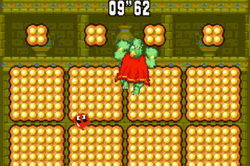 Hey, isn’t Donkey Kong: Barrel Blast relevant to this whole discussion on DK appearances? Gogglebob.com does not formally recognize any titles involving sexy lady kremlings and Lanky Kong.
Hey, isn’t Donkey Kong: Barrel Blast relevant to this whole discussion on DK appearances? Gogglebob.com does not formally recognize any titles involving sexy lady kremlings and Lanky Kong.- Story Time: DK King of Swing’s official plot is that the Kongs were going to have some manner of Monkey Olympics, but King K. Rool stole all the medals, and now DK has to venture through five or so worlds to reclaim all the gold before the games. What happened to simply having sports for the spirit of competition, Kongs? Do you really have to rely on these meaningless baubles? Do you actually need your patriarch to fight a gigantic, flaming bird so you can have a medal at the end of the day? You apes are too materialistic.
- Favorite Character: Less you missed the obvious parallels, the star of Clu-Clu Land is the final unlockable character. Clu-Clu is a beast… and incidentally a silly little circle. I like simple designs.
- For the Sequel: DK: King of Swing did receive a DS sequel titled DK: Jungle Climber. Its selling point is dropping the “cartoony” graphics of King of Swing for the more familiar “rendered” graphics of the 16-bit era. It’s otherwise a pretty pat sequel in gameplay and plot, and an inglorious end for this branch of the DK family tree.
- Did you know? Given he hasn’t yet returned for Donkey Kong Country Returns titles, DK: King of Swing and DK: Jungle Climber were the last titles where King K. Rool appeared as an antagonist. He’s performed a few times since then as a generic “player” in baseball games and alike, though, so it’s not like Smash Bros. was his only spotlight in the last decade. Maybe we’ll see more of the big lug in the future thanks to Smash. It certainly worked for Fire Emblem…
- Would I play again: I’m always reminded how much I like this game every time I play it. It certainly has its share of weird bits (what’s this about eating my banana stock for health?), but it feels very right, so I might chase that feeling again. And I have to defend my King of Swing medals…
What’s next? Random ROB has chosen… Ballz. Oh man, that game is balls. Please look forward to it, that, which is Ballz!
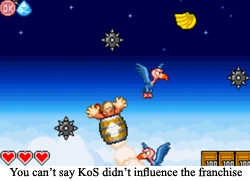

[…] Donkey Kong 64 (that was her sister, Tiny), but she did make it back in time for Donkey Konga and Jungle Climber. Now she seems to appear nearly every time we see Donkey, though, so it looks like her retirement […]